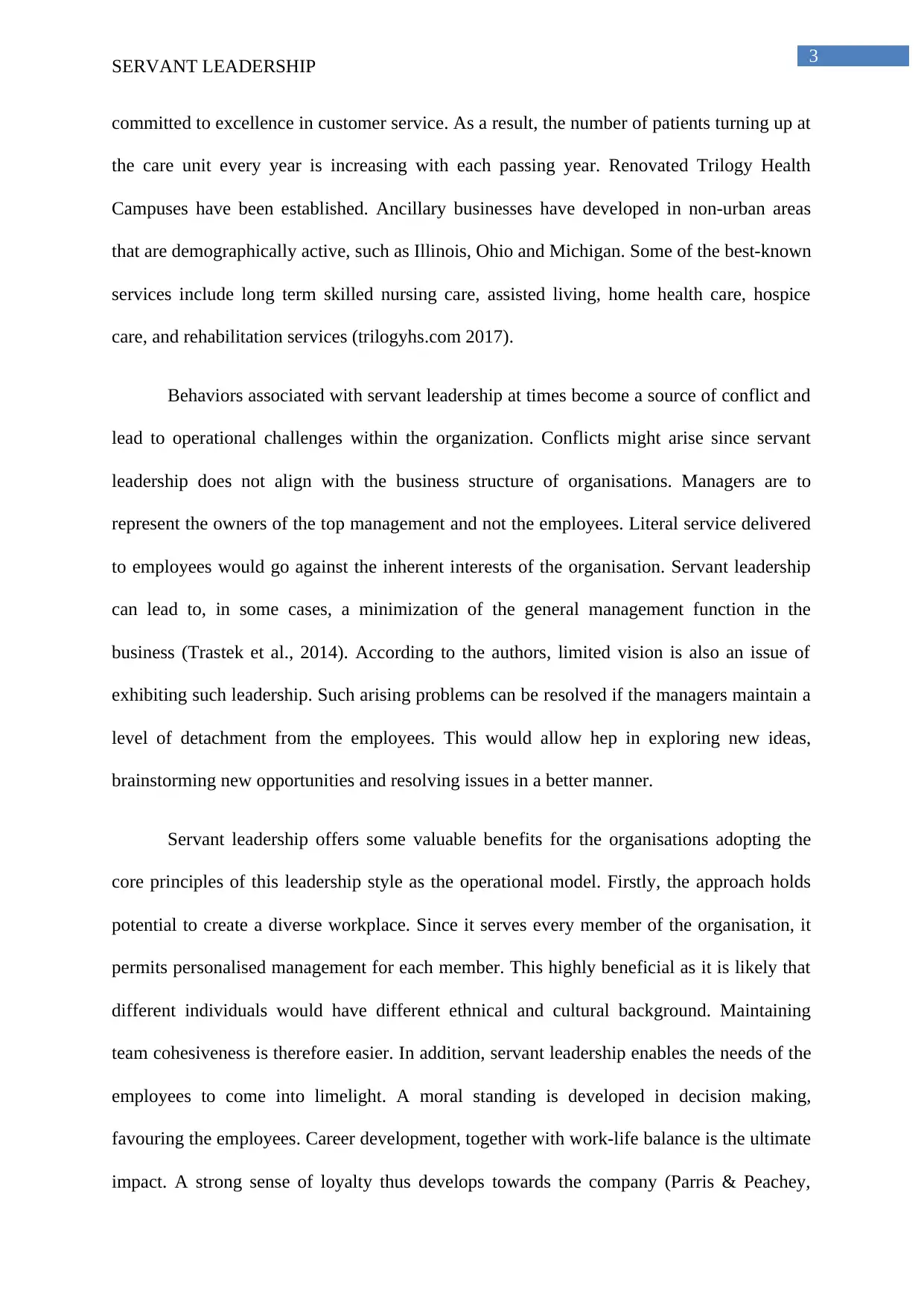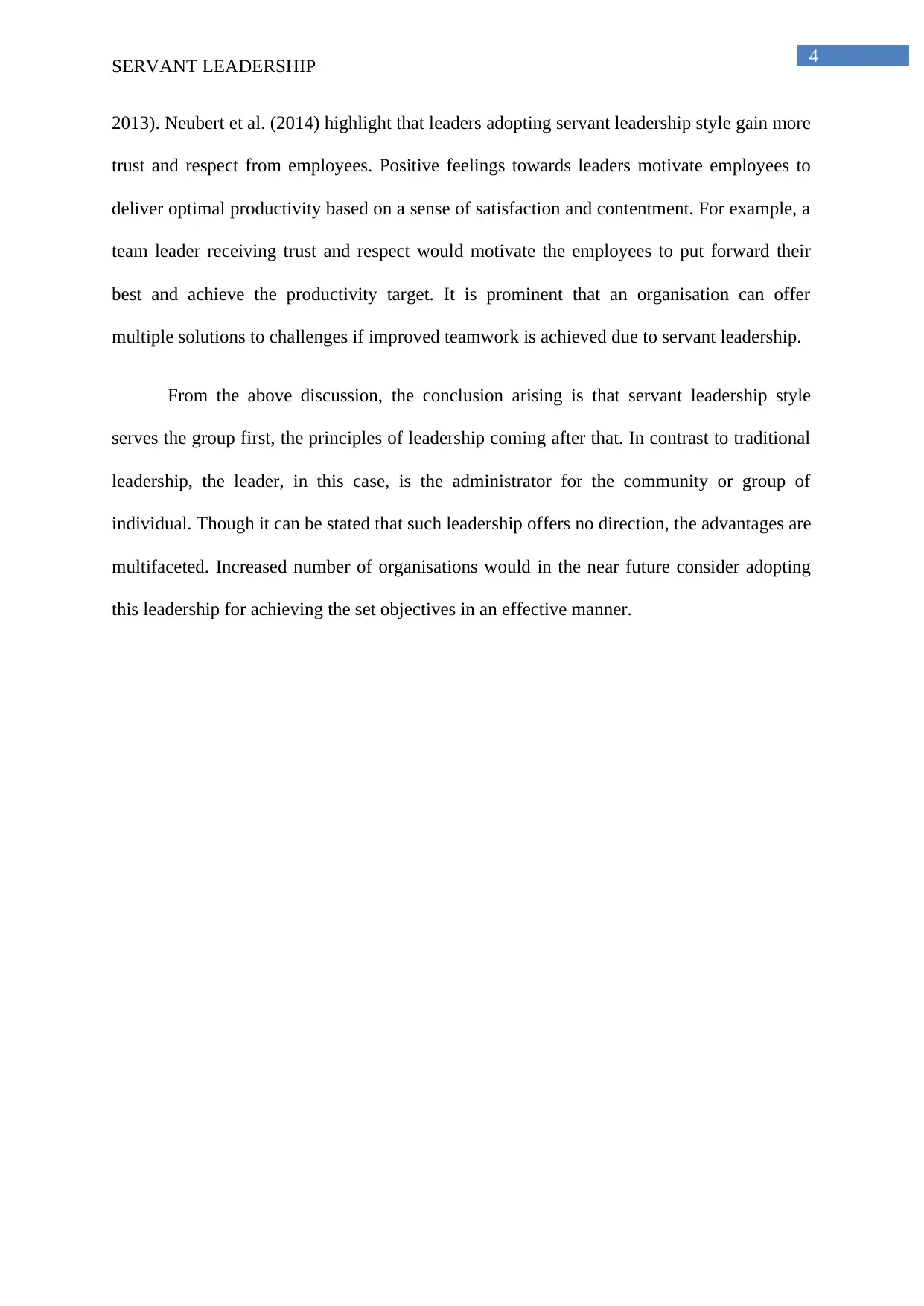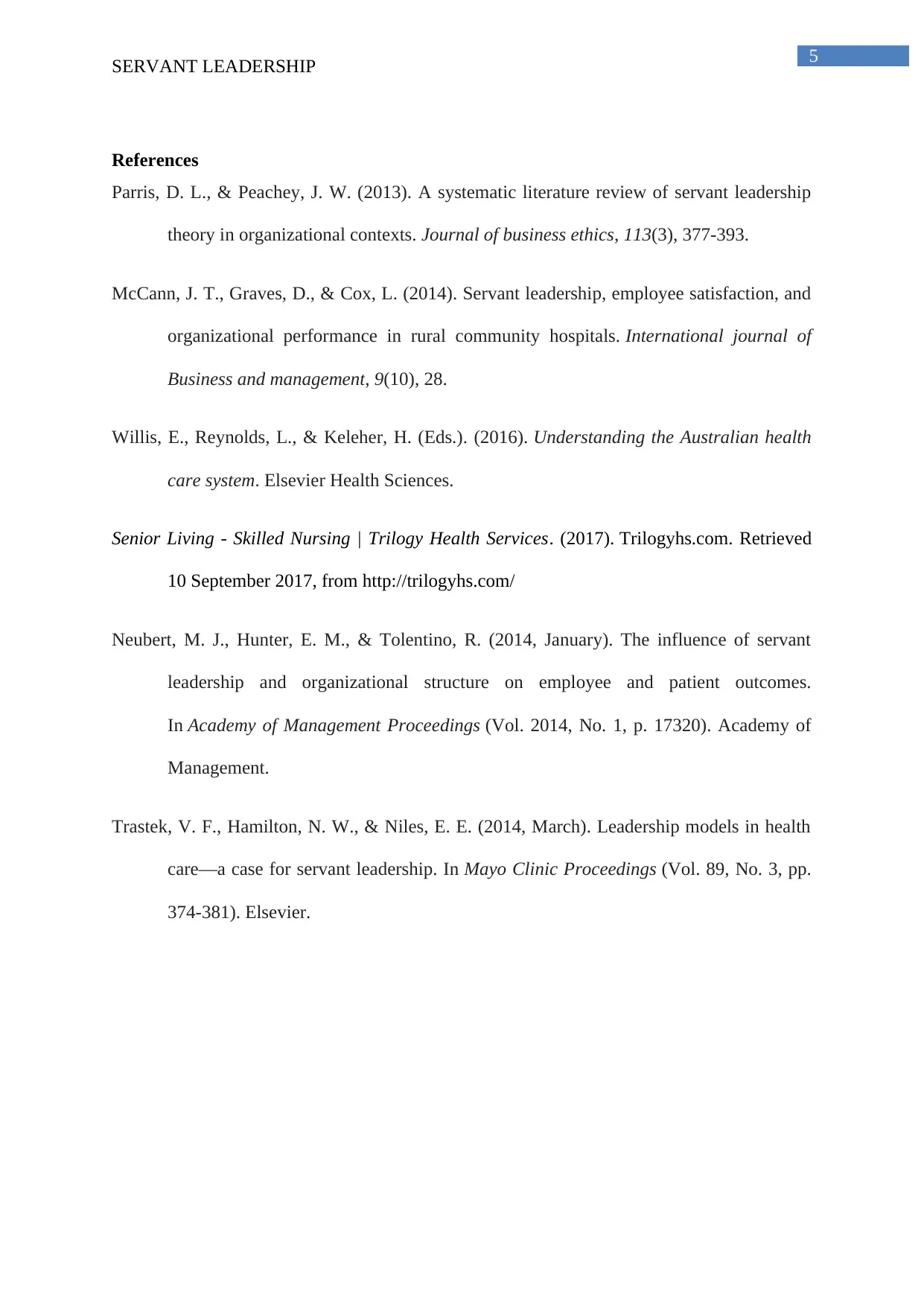Servant Leadership: Principles, Implementation, and Impacts
VerifiedAdded on 2019/10/30
|5
|1158
|127
Report
AI Summary
This report provides an in-depth analysis of servant leadership, a leadership philosophy emphasizing the well-being and growth of individuals and communities within an organization. The report highlights the principles of servant leadership, exemplified by organizations like Trilogy Health Services, which prioritize employee satisfaction and community service. It explores how servant leadership creates a positive work environment, fosters employee loyalty, and leads to improved customer service. Furthermore, the report examines the potential challenges of adopting servant leadership, such as conflicts with traditional business structures and the need for managers to maintain a balance between serving employees and the organization's overall goals. The discussion then shifts to the benefits of this leadership style, including creating diverse workplaces, prioritizing employee needs, and fostering trust and respect. The conclusion emphasizes the advantages of servant leadership in achieving organizational objectives effectively.

1Running head: SERVANT LEADERSHIP
Servant leadership
Name of student:
Name of university:
Author note:
Servant leadership
Name of student:
Name of university:
Author note:
Paraphrase This Document
Need a fresh take? Get an instant paraphrase of this document with our AI Paraphraser

2
SERVANT LEADERSHIP
Servant leadership is the set of practices and distinct philosophy that is known to
enrich the lies of individuals as structuring better organisation becomes the key focus. Such
leadership form is a timeless concept (McCann, 2014). One prominent organisation that
promotes servant leadership is Trilogy Health Services. The present paper highlights how the
organisation implements the principles of servant leadership and the particular commitments
the organisation makes to stakeholders regarding implementation of the leadership across the
community. The subsequent section of the paper describes how behaviours and concepts of
servant leadership can lead to organisational challenges as well the benefits of adopting this
leadership style as organisational, operational model.
Organisations, such as Trilogy Health Services have been recently putting the
emphasis on servant leadership that has the emphasis on the wellbeing and growth of
communities and individuals belonging to it. The organisation is proud to state that the
servant leadership culture is eminent within the organisational context since the employees
have embraced the values of the organisation (Willis et al., 2016). At the core of the
principles of Trilogy lies the statement that a servant’s heart is to be considered as a key to
every success. The organisation has created a working environment that motivates the
employees to come and deliver their work with pleasure. This kind of atmosphere makes the
employees dedicated. The management at the organisation is ready to cross the boundaries of
employer-employee relationship to engage the employees in a terrific work output. In
addition, the management encourages professional and personal growth through offering
highly structured benefits and programs. This permits them to establish employee satisfaction
that eventually leads to a low turnover. Employees uphold their vision of excellence, and this
is truely overwhelming.
The organisation has made commitments to stakeholders and this affects the
community as a whole in terms of common good. The service model is compassionately
SERVANT LEADERSHIP
Servant leadership is the set of practices and distinct philosophy that is known to
enrich the lies of individuals as structuring better organisation becomes the key focus. Such
leadership form is a timeless concept (McCann, 2014). One prominent organisation that
promotes servant leadership is Trilogy Health Services. The present paper highlights how the
organisation implements the principles of servant leadership and the particular commitments
the organisation makes to stakeholders regarding implementation of the leadership across the
community. The subsequent section of the paper describes how behaviours and concepts of
servant leadership can lead to organisational challenges as well the benefits of adopting this
leadership style as organisational, operational model.
Organisations, such as Trilogy Health Services have been recently putting the
emphasis on servant leadership that has the emphasis on the wellbeing and growth of
communities and individuals belonging to it. The organisation is proud to state that the
servant leadership culture is eminent within the organisational context since the employees
have embraced the values of the organisation (Willis et al., 2016). At the core of the
principles of Trilogy lies the statement that a servant’s heart is to be considered as a key to
every success. The organisation has created a working environment that motivates the
employees to come and deliver their work with pleasure. This kind of atmosphere makes the
employees dedicated. The management at the organisation is ready to cross the boundaries of
employer-employee relationship to engage the employees in a terrific work output. In
addition, the management encourages professional and personal growth through offering
highly structured benefits and programs. This permits them to establish employee satisfaction
that eventually leads to a low turnover. Employees uphold their vision of excellence, and this
is truely overwhelming.
The organisation has made commitments to stakeholders and this affects the
community as a whole in terms of common good. The service model is compassionately

3
SERVANT LEADERSHIP
committed to excellence in customer service. As a result, the number of patients turning up at
the care unit every year is increasing with each passing year. Renovated Trilogy Health
Campuses have been established. Ancillary businesses have developed in non-urban areas
that are demographically active, such as Illinois, Ohio and Michigan. Some of the best-known
services include long term skilled nursing care, assisted living, home health care, hospice
care, and rehabilitation services (trilogyhs.com 2017).
Behaviors associated with servant leadership at times become a source of conflict and
lead to operational challenges within the organization. Conflicts might arise since servant
leadership does not align with the business structure of organisations. Managers are to
represent the owners of the top management and not the employees. Literal service delivered
to employees would go against the inherent interests of the organisation. Servant leadership
can lead to, in some cases, a minimization of the general management function in the
business (Trastek et al., 2014). According to the authors, limited vision is also an issue of
exhibiting such leadership. Such arising problems can be resolved if the managers maintain a
level of detachment from the employees. This would allow hep in exploring new ideas,
brainstorming new opportunities and resolving issues in a better manner.
Servant leadership offers some valuable benefits for the organisations adopting the
core principles of this leadership style as the operational model. Firstly, the approach holds
potential to create a diverse workplace. Since it serves every member of the organisation, it
permits personalised management for each member. This highly beneficial as it is likely that
different individuals would have different ethnical and cultural background. Maintaining
team cohesiveness is therefore easier. In addition, servant leadership enables the needs of the
employees to come into limelight. A moral standing is developed in decision making,
favouring the employees. Career development, together with work-life balance is the ultimate
impact. A strong sense of loyalty thus develops towards the company (Parris & Peachey,
SERVANT LEADERSHIP
committed to excellence in customer service. As a result, the number of patients turning up at
the care unit every year is increasing with each passing year. Renovated Trilogy Health
Campuses have been established. Ancillary businesses have developed in non-urban areas
that are demographically active, such as Illinois, Ohio and Michigan. Some of the best-known
services include long term skilled nursing care, assisted living, home health care, hospice
care, and rehabilitation services (trilogyhs.com 2017).
Behaviors associated with servant leadership at times become a source of conflict and
lead to operational challenges within the organization. Conflicts might arise since servant
leadership does not align with the business structure of organisations. Managers are to
represent the owners of the top management and not the employees. Literal service delivered
to employees would go against the inherent interests of the organisation. Servant leadership
can lead to, in some cases, a minimization of the general management function in the
business (Trastek et al., 2014). According to the authors, limited vision is also an issue of
exhibiting such leadership. Such arising problems can be resolved if the managers maintain a
level of detachment from the employees. This would allow hep in exploring new ideas,
brainstorming new opportunities and resolving issues in a better manner.
Servant leadership offers some valuable benefits for the organisations adopting the
core principles of this leadership style as the operational model. Firstly, the approach holds
potential to create a diverse workplace. Since it serves every member of the organisation, it
permits personalised management for each member. This highly beneficial as it is likely that
different individuals would have different ethnical and cultural background. Maintaining
team cohesiveness is therefore easier. In addition, servant leadership enables the needs of the
employees to come into limelight. A moral standing is developed in decision making,
favouring the employees. Career development, together with work-life balance is the ultimate
impact. A strong sense of loyalty thus develops towards the company (Parris & Peachey,
⊘ This is a preview!⊘
Do you want full access?
Subscribe today to unlock all pages.

Trusted by 1+ million students worldwide

4
SERVANT LEADERSHIP
2013). Neubert et al. (2014) highlight that leaders adopting servant leadership style gain more
trust and respect from employees. Positive feelings towards leaders motivate employees to
deliver optimal productivity based on a sense of satisfaction and contentment. For example, a
team leader receiving trust and respect would motivate the employees to put forward their
best and achieve the productivity target. It is prominent that an organisation can offer
multiple solutions to challenges if improved teamwork is achieved due to servant leadership.
From the above discussion, the conclusion arising is that servant leadership style
serves the group first, the principles of leadership coming after that. In contrast to traditional
leadership, the leader, in this case, is the administrator for the community or group of
individual. Though it can be stated that such leadership offers no direction, the advantages are
multifaceted. Increased number of organisations would in the near future consider adopting
this leadership for achieving the set objectives in an effective manner.
SERVANT LEADERSHIP
2013). Neubert et al. (2014) highlight that leaders adopting servant leadership style gain more
trust and respect from employees. Positive feelings towards leaders motivate employees to
deliver optimal productivity based on a sense of satisfaction and contentment. For example, a
team leader receiving trust and respect would motivate the employees to put forward their
best and achieve the productivity target. It is prominent that an organisation can offer
multiple solutions to challenges if improved teamwork is achieved due to servant leadership.
From the above discussion, the conclusion arising is that servant leadership style
serves the group first, the principles of leadership coming after that. In contrast to traditional
leadership, the leader, in this case, is the administrator for the community or group of
individual. Though it can be stated that such leadership offers no direction, the advantages are
multifaceted. Increased number of organisations would in the near future consider adopting
this leadership for achieving the set objectives in an effective manner.
Paraphrase This Document
Need a fresh take? Get an instant paraphrase of this document with our AI Paraphraser

5
SERVANT LEADERSHIP
References
Parris, D. L., & Peachey, J. W. (2013). A systematic literature review of servant leadership
theory in organizational contexts. Journal of business ethics, 113(3), 377-393.
McCann, J. T., Graves, D., & Cox, L. (2014). Servant leadership, employee satisfaction, and
organizational performance in rural community hospitals. International journal of
Business and management, 9(10), 28.
Willis, E., Reynolds, L., & Keleher, H. (Eds.). (2016). Understanding the Australian health
care system. Elsevier Health Sciences.
Senior Living - Skilled Nursing | Trilogy Health Services. (2017). Trilogyhs.com. Retrieved
10 September 2017, from http://trilogyhs.com/
Neubert, M. J., Hunter, E. M., & Tolentino, R. (2014, January). The influence of servant
leadership and organizational structure on employee and patient outcomes.
In Academy of Management Proceedings (Vol. 2014, No. 1, p. 17320). Academy of
Management.
Trastek, V. F., Hamilton, N. W., & Niles, E. E. (2014, March). Leadership models in health
care—a case for servant leadership. In Mayo Clinic Proceedings (Vol. 89, No. 3, pp.
374-381). Elsevier.
SERVANT LEADERSHIP
References
Parris, D. L., & Peachey, J. W. (2013). A systematic literature review of servant leadership
theory in organizational contexts. Journal of business ethics, 113(3), 377-393.
McCann, J. T., Graves, D., & Cox, L. (2014). Servant leadership, employee satisfaction, and
organizational performance in rural community hospitals. International journal of
Business and management, 9(10), 28.
Willis, E., Reynolds, L., & Keleher, H. (Eds.). (2016). Understanding the Australian health
care system. Elsevier Health Sciences.
Senior Living - Skilled Nursing | Trilogy Health Services. (2017). Trilogyhs.com. Retrieved
10 September 2017, from http://trilogyhs.com/
Neubert, M. J., Hunter, E. M., & Tolentino, R. (2014, January). The influence of servant
leadership and organizational structure on employee and patient outcomes.
In Academy of Management Proceedings (Vol. 2014, No. 1, p. 17320). Academy of
Management.
Trastek, V. F., Hamilton, N. W., & Niles, E. E. (2014, March). Leadership models in health
care—a case for servant leadership. In Mayo Clinic Proceedings (Vol. 89, No. 3, pp.
374-381). Elsevier.
1 out of 5
Related Documents
Your All-in-One AI-Powered Toolkit for Academic Success.
+13062052269
info@desklib.com
Available 24*7 on WhatsApp / Email
![[object Object]](/_next/static/media/star-bottom.7253800d.svg)
Unlock your academic potential
Copyright © 2020–2025 A2Z Services. All Rights Reserved. Developed and managed by ZUCOL.





